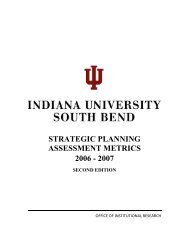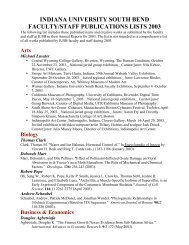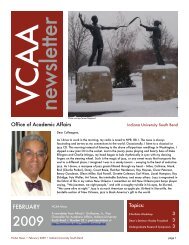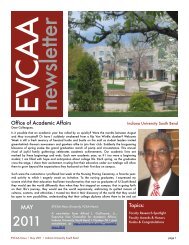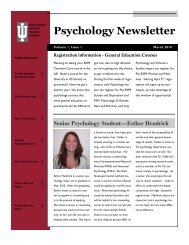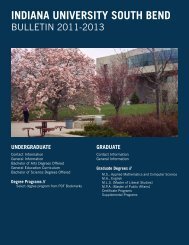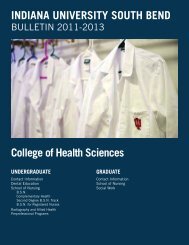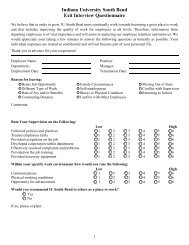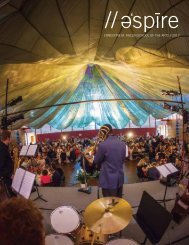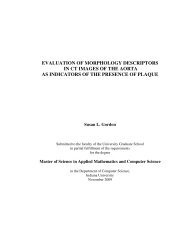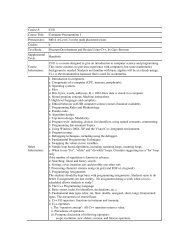Current version - Indiana University South Bend
Current version - Indiana University South Bend
Current version - Indiana University South Bend
Create successful ePaper yourself
Turn your PDF publications into a flip-book with our unique Google optimized e-Paper software.
2943 IU SOUTH BEND COURSE DESCRIPTIONS<br />
CMLT-C 290<br />
CMLT-C 293<br />
CMLT-C 294<br />
CMLT-C 297<br />
CMLT-C 310<br />
CMLT-C 390<br />
CMLT-C 393<br />
CMLT-C 394<br />
survey of film history (3 cr.)<br />
This survey of United States film history<br />
begins with the origins of cinema. In this<br />
course, students develop interpretive skills<br />
relevant to the study of film by examining<br />
the history of major film developments<br />
in the United States. Lectures, readings,<br />
and writing assignments address critical<br />
positions on cinema and strategies for<br />
understanding and interpreting film<br />
form.<br />
HISTORY OF THE MOTION PICTURE I (3 cr.)<br />
This course studies the evolution of<br />
cinema as an institution and art form,<br />
moving from the origins of cinema in the<br />
late nineteenth century through World<br />
War II. Credit not given for both CMLT-C<br />
293 and CMLT-C 393.<br />
HISTORY OF THE MOTION PICTURE II (3 cr.)<br />
This course studies major national cinemas<br />
and film movements from post-World War<br />
II to the present. Credit not given for both<br />
CMLT-C 294 and CMLT-C 394.<br />
FILM GENRES (3 cr.)<br />
This course investigates the nature,<br />
particularly the political nature of genre<br />
films. Topics covered may include genre<br />
cycles, and gender and genre. Genres<br />
covered may include melodrama, comedy,<br />
action, science fiction, the western and<br />
the thriller, as well as others.<br />
Film adaptations (3 cr.)<br />
This course focuses on both literary<br />
analysis and formal film analysis. Study<br />
the relationship between the literary and<br />
the cinematic <strong>version</strong> of several texts,<br />
and consider the strategies, agendas,<br />
and pleasures of each <strong>version</strong>, and of the<br />
process of adaptation itself.<br />
Film and Society (3 cr.)<br />
Film in relation to politics, ideology, and<br />
social history.<br />
History of European and American<br />
Films 1 (3 cr.)<br />
Survey of the development of cinema<br />
from its earliest beginnings, stressing film<br />
form, the silent era, emergence of genres<br />
such as westerns and musicals, the rise of<br />
the star system and big studios, issues of<br />
censorship, the transition to sound, and<br />
the dominance of Hollywood.<br />
History of European and American<br />
Films 2 (3 cr.)<br />
Survey of European and American films<br />
since World War II, stressing wartime<br />
CMLT-C 395<br />
CMLT-C 491<br />
CMLT-C 603<br />
CMLT-T 190<br />
CMLT-T 390<br />
films, Neorealism, Film Noir, the New<br />
Wave, modern genres, impact of television,<br />
major developments of national industries,<br />
and industrial and artistic changes.<br />
Directors covered may include Bergman,<br />
Hitchcock, Allen, Bunuel, Fellini, Truffaut,<br />
Eisenstein, Renoir, Welles, Fassbinder, De<br />
Sica, and Antonioni.<br />
The Documentary film (3 cr.)<br />
Although some of the earliest films ever<br />
made were documentaries, the end of<br />
the twentieth century witnessed a rise<br />
in reality-based filmmaking. This course<br />
studies the history of the documentary<br />
film and its efforts to represent reality<br />
and truth.<br />
Authorship in the Cinema (3 cr.)<br />
Topic varies: in-depth analysis of individual<br />
film makers, viewed as authors. May be<br />
repeated once, with a different topic.<br />
TOPICS in comparative literature<br />
(4 cr.)<br />
Explores specific problems between two<br />
literatures or between literature and<br />
another area in the humanities. Variable<br />
topics course; may be repeated once for<br />
credit.<br />
literary and intellectual traditions<br />
(3 cr.)<br />
Explores, in an interdisciplinary way,<br />
one of the great humanistic traditions of<br />
inquiry regarding one of the following<br />
themes: ideas of self, truth, beauty,<br />
community, nature, or conflict. Writingintensive,<br />
discussion-focused.<br />
literary and intellectual traditions<br />
(3 cr.)<br />
Interdisciplinary exploration of a<br />
humanistic tradition of inquiry regarding<br />
one of the following themes: ideas of self;<br />
of truth; of beauty; of community; of<br />
nature; or of conflict. Writing intensive,<br />
discussion-focused. Attention to primary<br />
texts and research materials.<br />
COAS: College of Arts and Sciences<br />
COAS-Q 110<br />
Introduction to information<br />
literacy (1 cr.)<br />
This course examines information<br />
structure and organization, as well<br />
as teaching techniques and skills for<br />
effectively identifying, acquiring,<br />
evaluating, using, and communicating<br />
information in various formats.<br />
P = Prerequisite, R = Recommended, C = Concomitant, VT = Variable Title<br />
I = fall semester, II = spring semester, S = summer session(s)



